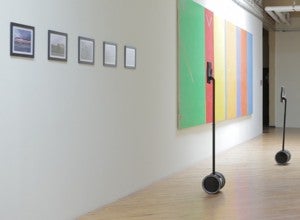
Look out, here comes another iPad on wheels.
To feed our evidently voracious need to be in two places at once, robotics company Double Robotics has added its contribution to the ever growing pool of iPad-based telepresence robots.
The first version of ‘Double’ totes its iPad around on an aluminum base and urethane and plastic wheels. A kickstand keeps it upright when not in use and, when rolling, its two wheels are gyroscopically balanced like a Segway. It’s powered by a stock motor and controlled with a separate iPad, equipped with an iOS, custom control system. The video chat is run by TokBox’s Open Tok API and applications, a set of tools that allows developers to add FaceTime features to any iOS app. Now you’re ready to wheel your Double between cubicles at the office or pop into the kitchen at grandma’s house and strike up a telepresence conversation. Your robotic “body double” can roam anywhere there’s Wi-Fi (and doors that open automatically).
Watch the following video to see Double in action. It’s like an iPad on a Segway.
At the outset Double doesn’t seem so different from iRobot’s Ava, Willow Garage’s Texai, Ctrl Works’ Telepresence Puppet, or iRobot/InTouch’s RP-VITA. The basic idea is the same, a mobile unit on which to move a tablet or notebook. But despite an already crowded field, Double seems to be separating itself from the competition. Their first production run has already sold out. If you want one, you’ll have to wait until next year.
The difference? While an Ava will run you tens of thousands of dollars, and with its cute robotic head QB by Anybot is perhaps more appealing than an iPad,
but the basic package, which runs $9,700, is not as attractive as Double’s. At $1,999 per robot (not including the price of the iPads), Double is easily the cheapest telepresence robot in the market. No doubt its simple – and elegant – design not only appeals to consumers, but to its affordable price.
Cann got the idea for Double while working for Taptic Toys and didn’t have time to travel to China to inspect the facilities of a prospective manufacturer. It’s a great idea, using technology to be in two places at once. In addition to tele-visiting colleagues and work sites from the comfort of your home, or faraway relatives, telepresence robots can be placed in museums and other historial sites around the world so that we can get a taste of being there without actually being there. Seeing all the Segway-mounted tourists in Washington DC makes me wonder if we couldn’t mount some robots on tracks and give them the run of the city.
In reality, though, we’ll have to wait and see if telepresence robots are as handy in the real world as they seem on paper. My guess is that navigation issues would be the main obstacle (pun intended) to these robots going mainstream. Sure they do great on flat, smooth surfaces, but how well would they navigate rug edges, cable wires or inclines? The only way to find out and work through these issues is to put them to the test, and given Double’s popularity, it may just be the telepresence robot to lead the way.
[image credits: Double Robotics]
images: Double Robotics
video: Double Robotics



